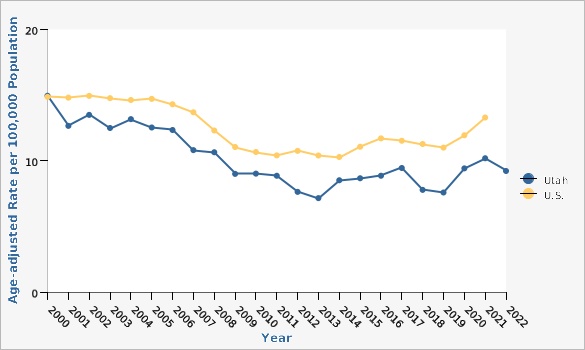PHOM Indicator Profile Report of Motor Vehicle Traffic Crash Deaths
Why Is This Important?
In Utah during 2019, motor vehicle traffic crashes (MVTCs) accounted for 231 deaths. This was a decrease from 238 deaths in 2018. MVTCs were one of the main injury causes of death.Data Sources
- Utah Death Certificate Database, Office of Vital Records and Statistics, Utah Department of Health
- Population Estimates: National Center for Health Statistics (NCHS) through a collaborative agreement with the U.S. Census Bureau, IBIS Version 2018
- National Center for Injury Prevention and Control's Web-based Injury Statistics Query and Reporting System (WISQARS)
Data Notes
ICD-10 codes V02-04 [.1-.9], V09.2, V12-14 [.3-.9], V19 [.4-.6], V20-28 [.3-.9], V29-79 [.4-.9], V80 [.3-.5], V81-82 [.1], V83-86 [.0-.3], V87 [.0-.8], V89.2. [[br]][[br]] Data have been age-adjusted to the U.S. 2000 standard population.Risk Factors
The five most important factors contributing to motor vehicle traffic crash injuries are not wearing a seat belt, drowsy driving, impaired driving (alcohol or drugs), aggressive driving, and distracted driving. Not using a safety belt or a child safety restraint while traveling in a motor vehicle greatly increases the chance of being injured or killed in a crash. When not using these safety devices, a person is more likely to be ejected from the vehicle. A person's driving ability is affected by a Blood Alcohol Concentration (BAC) as low as .02%. The likelihood of a crash increases significantly over .05%. Twelve percent of fatal crashes in Utah involve alcohol-impaired drivers^1^. When alcohol is involved, crashes tend to be more severe. As blood alcohol levels increase, balance, coordination, and reasoning ability worsen. Additional information can be found at [https://highwaysafety.utah.gov/crash-data/utah-crash-summaries/].[[br]] [[br]] ---- 1. Utah Department of Public Safety, ''Utah Crash Summary 2016''How Are We Doing?
The motor vehicle traffic crash (MVTC) death rate was 7.6 deaths per 100,000 population in 2019. This was a 3% decrease from the 2018 rate of 7.8. The 2019 rate was the lowest in the last six years. (All rates are age-adjusted.)What Is Being Done?
The Violence and Injury Prevention Program (VIPP) provides funding to the 13 local health departments in Utah to implement motor vehicle safety programs and Safe Kids coalitions/chapters activities. These programs focus on child passenger safety and teen driving. The VIPP partners with the Utah Teen Driving Safety Task Force, Zero Fatalities Program, and Utah Highway Safety Office, among other state and local agencies to prevent MVTC deaths. For the past eight years, a book has been published that tells the stories of teens who died in motor vehicle-related crashes. The book is distributed to each drivers education instructor in the state as a prevention tool. The books can be downloaded at [http://www.health.utah.gov/vipp/teens/teen-driving/] or [http://zerofatalitiesut.com/dont-drive-stupid/]. Many other partners play a role in the prevention of motor vehicle traffic crash deaths including the Utah Department of Public Safety, Utah Department of Transportation, Utah legislature, law enforcement, media, vehicle manufacturers, emergency response, and medical treatment.Healthy People Objective: Reduce motor vehicle crash-related deaths per 100,000 population
U.S. Target: 12.4 deaths per 100,000 populationState Target: 8.7 deaths per 100,000 population

